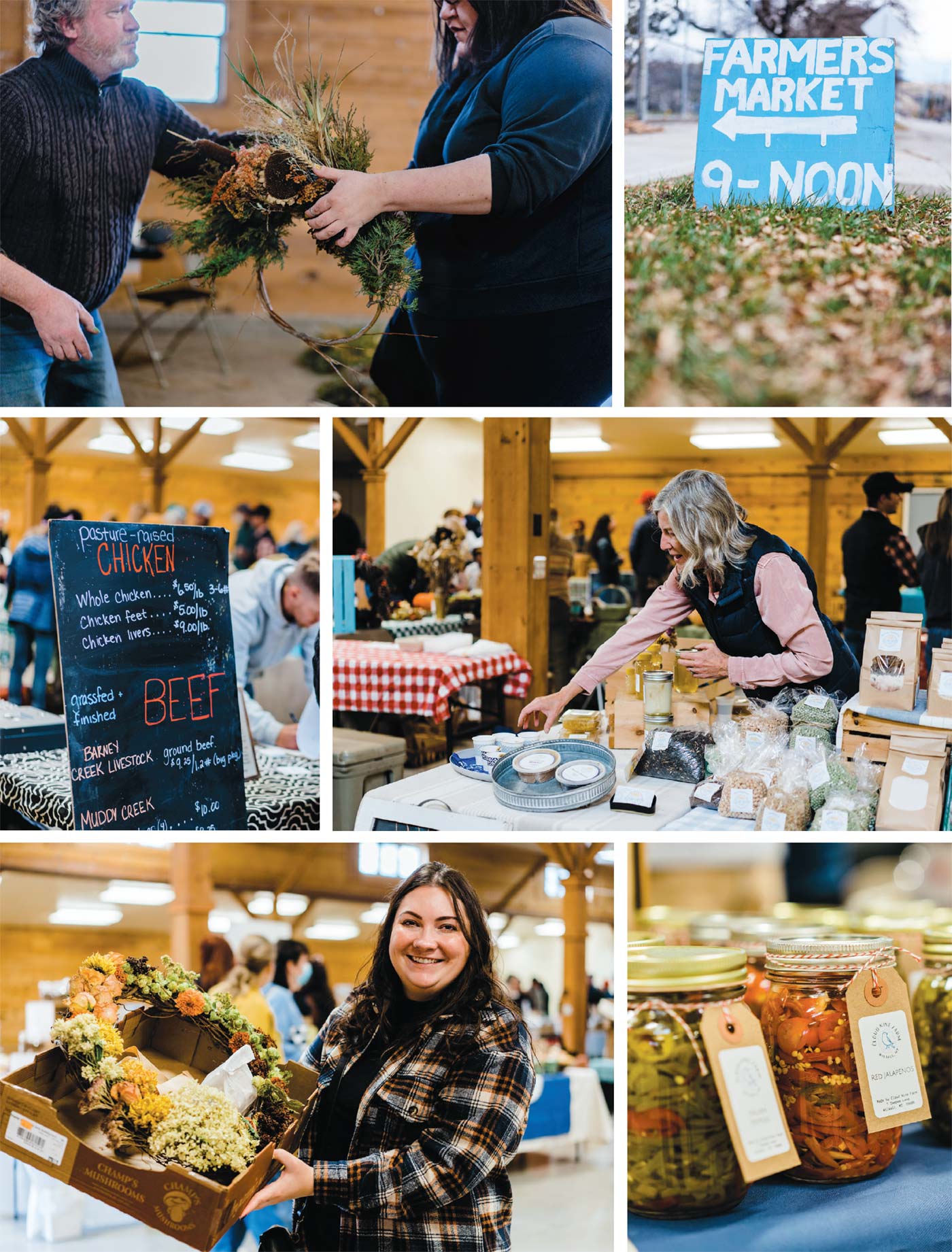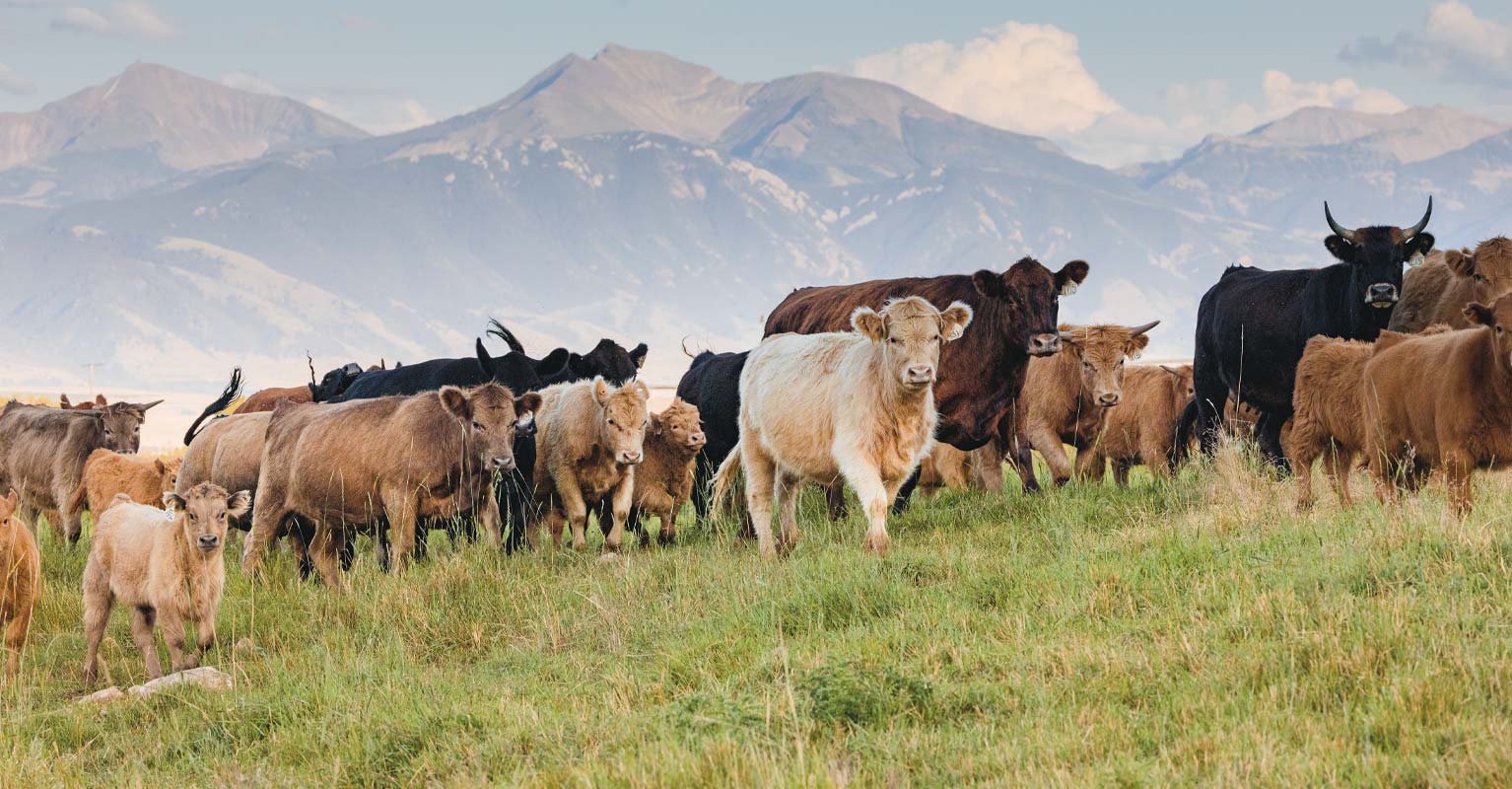The Bozeman Winter Farmers’ Market Warms and Welcomes the Whole Community
Bozeman rests under a gray blanket as snowflakes drift quietly past the Emerson Cultural Center. In years past, bundled figures would wander through the Emerson’s double doors and follow their noses to the ballroom. There, they were greeted by yellow string lights, live music, and banter between old friends during the Bozeman Winter Farmers’ Market.
After eleven years at the Emerson, the Bozeman Winter Farmers’ Market opened this fall in a new location. Now, the Gallatin County Fairgrounds hosts the market’s lively crowds, roughly every other Saturday from September to May.
At the market, I lean back in a metal folding chair and close my eyes. Murmurs from the crowd mingle with a few strummed guitar chords. Waves of laughter rise to the rafters. Dried flowers swish across the concrete floor. A package crinkles near my ear. Frigid air touches the back of my neck and I shiver. It’s not as warm as the Emerson—the doors stay propped open for air circulation—and occasional drafts from the open doors remind me that nourishing food and real connection can keep the cold and gloom at bay.
There were a few farmers selling produce out of their trunks in the bitter Bozeman winter, but not much else. So, the producers created a new outlet: the first winter market.
IT’S WHO YOU KNOW
The fairgrounds venue is a space reminiscent of the winter market’s inception, which was a potluck gathering known as Christmas in the Country that included Matt and Jacy Rothschiller, co-owners and operators of Gallatin Valley Botanical at Rocky Creek Farm, and rancher Jenny Karhl.
“At one of the gatherings we were discussing the fact that there was really no outlet to sell anything in the wintertime,” says LaVonne Stucky, owner of The Wool Mill at Serenity Sheep Farm. She was right. There were a few farmers selling produce out of their trunks in the bitter Bozeman winter, but not much else. So, the producers created a new outlet: the first winter market.
This foresight has been a boon to the community. More than a decade later, the heart of the market is still the same: to establish a year-round customer base for Bozeman’s farmers and growers and, in the process, build relationships.
The market is run like a nonprofit, meaning its owners, the Rothschillers, are happy to break even every year, but it’s not officially a 501(c)(3). The Rothschillers encourage anyone who wants to volunteer for any of the markets to reach out to the market manager, Rylie Neely.
Neely, who became manager in September 2021, speaks to the relationships that form between vendors, who often ask to have their booths near friends’. “[They] come in every morning, help each other set up and catch up on each other’s lives since the last market,” she says. “And same thing with customers who come back every weekend.”
The vendors recognize and appreciate their customer loyalty. The market has been through many iterations in its lifetime, but the previous several years have reminded everyone of the value of face-to-face interactions.
“It’s that ultimate connection to the community,” says Dan Spiwak of Amaltheia Organic Dairy.
Amaltheia has been selling cheese in Bozeman markets for over two decades, and veggies and pork for at least ten years. The dairy’s booth is often headed up by Spiwak, who has a lighthearted, easy rapport with customers, calling people by name and joking with old friends.
When asked why Amaltheia keeps coming back to the market, Spiwak replied, “for Amaltheia I reckon it’s a way that they don’t have to have a middleman. They get to show the faces of pretty much everyone who is a part of this organization.”
Amaltheia’s best-selling cheese at the market is the garlic chive chevre and their veggies are popular too. “The cheese really hits, but if I’m talking veggies, which I love … the greenhouse folks just do amazing tomatoes that every year light me up.”

PRESERVING ACCESS
How is it possible to grow fresh produce, like tomatoes, in the middle of a Bozeman winter? Every farmer has a unique system. Some have large storage areas for potatoes, winter squash, and root vegetables, while others run unheated hoop houses for plants, like spinach, that can freeze and thaw several times and still live. Others use heated greenhouses to grow microgreens and lettuce, while some use hydroponic technology to prolong the life of food throughout the winter. Some vendors, though, prolong the fruits of summer in other ways.
Amy Warde of Red Hen Jams offers dozens of rich, bright varieties of preserved jam for customers to sample and savor. Warde’s bestsellers are huckleberry-raspberry, flathead cherry, and strawberry-rhubarb.
“It is important to me to have a winter market for income, for socializing, and to maintain my customer base,” she says. “Also, markets are vital for small producers to maximize their income by reducing shipping and traveling.”
Another way vendors maximize income is through market dollars. Customers can purchase items at the market with cash and credit cards, but Neely also accepts credit cards at the main market booth, where customers can pay for market dollars that can be spent with the vendors. These market dollars help the farmers and vendors avoid additional fees because they receive 100 percent of what their product is worth, rather than having to pay a fee for card-swiping mechanisms.
Jim Foster of High Country Wreaths appreciates the market’s financial support for the vendors, and though he can’t set out taste samples, his products offer a feast for other senses. Foster weaves varying shades of Rocky Mountain juniper with dried flowers, golden grass, and pinecones into wreaths that, when shuffled around, release the pungent, nostalgic smell of juniper.
Foster especially appreciates that the winter market supports people who want to use the Supplemental Nutrition Assistance Program (SNAP). “I think farmers are a tremendous asset to this community, and I think that helps people gain access to quality produce in their diet.”
Foster is highlighting a main goal of the market: to ensure its high-quality offerings are accessible to all. The market accepts electronic benefit transfer (EBT) cards and can match up to $20 for fruits and vegetables to those who are part of SNAP. “I think local food has a tendency to be seen as something for rich folks, which is not necessarily the case at all,” says former market manager Amanda Garant. “I think it’s important for us to change the conversation around who local food is for: It’s for everybody.”
Foster agrees and tries to keep his products affordable. “In my case, I’m selling beauty; I’m not selling sustenance, but I think beauty’s equally important,” he says. “I love when I know people, and I know they can’t afford it, so I make accommodations so that they have something pretty to go home with.”
Foster has seen immense change since he moved to Bozeman in 1967. Although some aspects of Bozeman’s growth have been difficult to watch, he’s grateful for the market. “I think it is just emblematic of Bozeman’s support for local, sustainable produce and gardening.”
“There’s definitely a connection to the food here that maybe you wouldn’t find at other markets. People want to know the story behind the ingredients.” —Charly Blackwood, Furrow & Fly
OLD AND NEW FLAVORS
While Bozeman’s expansion has meant new customers at every market, vendors still highlight the importance of people who come back, week after week.
Jeff Ferguson of Bar 77 Ranch has been at the market for about seven years and says 50–60 percent of their Angus beef is sold to repeat customers. Sisters Amanda Wlaysewski and Alena Chacon of Kvichak Fish Co. have, similarly, been coming for about seven years. “We see the same people week after week,” Wlaysewski says. “You really know people like your stuff because it’s the same people coming back, and we need that feedback as a business.”
Kvichak Fish Co. heads up to Bristol Bay, Alaska, each May to work the commercial halibut and salmon season. There’s a small group of local fishermen that fish the catch and then the sisters run a small custom processing plant. For eight weeks straight they work with a small staff to hand-cut and package all the fish before returning to Bozeman in time for the fall market.
“We didn’t know how valuable [the market] was until COVID,” says Wlaysewski. “We don’t take it for granted anymore. We were so grateful that they made all the adjustments so we could keep the market open because that would have been a huge void for us.”
While vendors and customers alike value old friendships and consistent products, COVID has not stopped Bozeman’s eagerness for new flavors.
Benjamin Deuling of SporeAttic felt this love when he first held a booth at the 2020 winter market. (See page 24 for more about his gourmet mushroom farm.) “We officially launched and made our first sale at the Halloween market in 2020— wearing costumes, of course,” Deuling says. “Pretty much immediately, we had a line of excited folks who had never seen mushrooms like this before, and we sold out in 45 minutes.” At every market, Deuling charges the same price for different mushrooms to communicate the idea that no mushroom is better than the other. “It’s a blast to explain our mushrooms and our company’s story to people who have never seen this before,” he says. “The excitement on people’s faces never gets old.”
Charly Blackwood and Will Shanahan, co-owners of Furrow & Fly, felt that excitement when they started coming in December 2020. Blackwood credits both customers and the other vendors with the inspiration to keep going forward with the business. One product that customers have inspired is a Kamut Sourdough English Muffin, which is fully organic. “There’s definitely a connection to the food here that maybe you wouldn’t find at other markets,” Blackwood says. “People want to know the story behind the ingredients.” This interest has motivated Blackwood and Shanahan to source their ingredients responsibly to reflect that they are a Montana business.
One new business that debuted at the market in November 2021 was Pasta Andare. Co-owners Jack Stewart and Tomas Scariano spent 12 hours preparing pasta the day before their first market. “We definitely didn’t know how much to make or how much we were going sell,” Stewart says. “And we ended up selling out halfway through!” One of their sold-out pastas was a gorgeous quattro formaggi ravioli that boasted vibrant stripes of beet dough filled with Amaltheia’s smoked chevre, whole-milk ricotta, parmesan, and mascarpone cheese.
These new vendors may soon become part of the core group that has been in attendance since the beginning. As Bozeman continues to grow and adapt, the market will too, and there’s no doubt that it will remain an integral part of the local food system.




